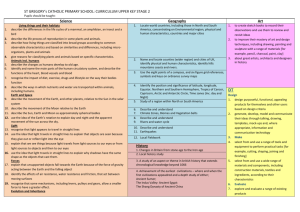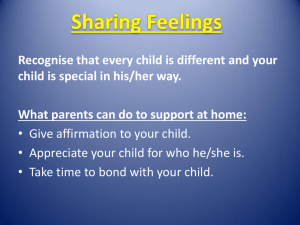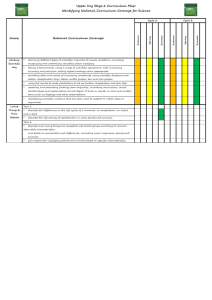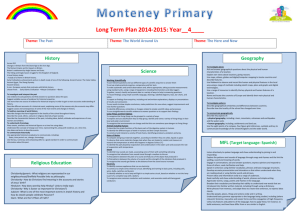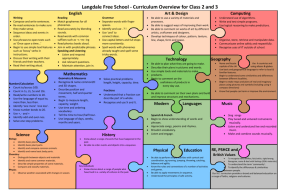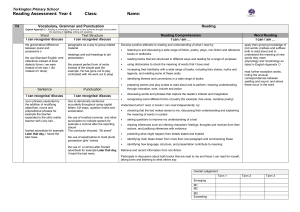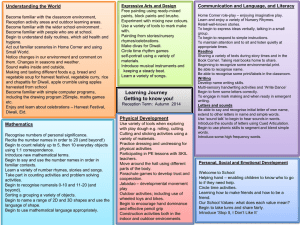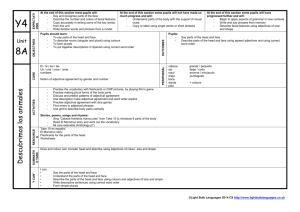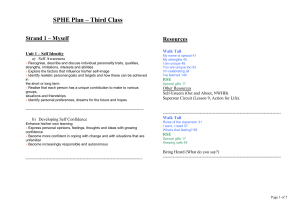Year 6 curriculum overview
advertisement
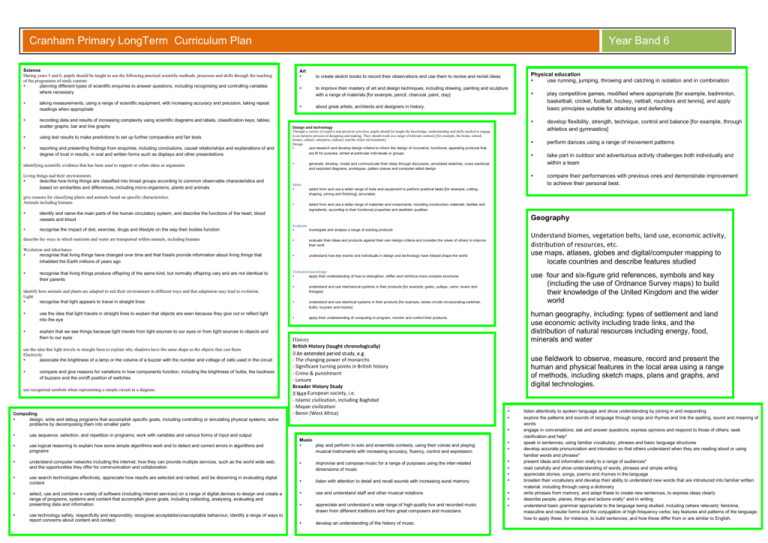
Cranham Primary LongTerm Curriculum Plan Year Band 6 Science During years 5 and 6, pupils should be taught to use the following practical scientific methods, processes and skills through the teaching of the programme of study content: planning different types of scientific enquiries to answer questions, including recognising and controlling variables where necessary taking measurements, using a range of scientific equipment, with increasing accuracy and precision, taking repeat readings when appropriate recording data and results of increasing complexity using scientific diagrams and labels, classification keys, tables, scatter graphs, bar and line graphs using test results to make predictions to set up further comparative and fair tests reporting and presenting findings from enquiries, including conclusions, causal relationships and explanations of and degree of trust in results, in oral and written forms such as displays and other presentations identifying scientific evidence that has been used to support or refute ideas or arguments to create sketch books to record their observations and use them to review and revisit ideas Physical education use running, jumping, throwing and catching in isolation and in combination to improve their mastery of art and design techniques, including drawing, painting and sculpture with a range of materials [for example, pencil, charcoal, paint, clay] about great artists, architects and designers in history. play competitive games, modified where appropriate [for example, badminton, basketball, cricket, football, hockey, netball, rounders and tennis], and apply basic principles suitable for attacking and defending develop flexibility, strength, technique, control and balance [for example, through athletics and gymnastics] perform dances using a range of movement patterns take part in outdoor and adventurous activity challenges both individually and within a team compare their performances with previous ones and demonstrate improvement to achieve their personal best. Design and technology Through a variety of creative and practical activities, pupils should be taught the knowledge, understanding and skills needed to engage in an iterative process of designing and making. They should work in a range of relevant contexts [for example, the home, school, leisure, culture, enterprise, industry and the wider environment]. Design use research and develop design criteria to inform the design of innovative, functional, appealing products that are fit for purpose, aimed at particular individuals or groups generate, develop, model and communicate their ideas through discussion, annotated sketches, cross-sectional and exploded diagrams, prototypes, pattern pieces and computer-aided design Living things nad their environments describe how living things are classified into broad groups according to common observable characteristics and based on similarities and differences, including micro-organisms, plants and animals Make give reasons for classifying plants and animals based on specific characteristics. Animals including humans identify and name the main parts of the human circulatory system, and describe the functions of the heart, blood vessels and blood recognise the impact of diet, exercise, drugs and lifestyle on the way their bodies function select from and use a wider range of tools and equipment to perform practical tasks [for example, cutting, shaping, joining and finishing], accurately select from and use a wider range of materials and components, including construction materials, textiles and ingredients, according to their functional properties and aesthetic qualities Geography Evaluate investigate and analyse a range of existing products describe the ways in which nutrients and water are transported within animals, including humans .. Wcolution and inheritance recognise that living things have changed over time and that fossils provide information about living things that inhabited the Earth millions of years ago evaluate their ideas and products against their own design criteria and consider the views of others to improve their work understand how key events and individuals in design and technology have helped shape the world Technical knowledge apply their understanding of how to strengthen, stiffen and reinforce more complex structures recognise that living things produce offspring of the same kind, but normally offspring vary and are not identical to their parents identify how animals and plants are adapted to suit their environment in different ways and that adaptation may lead to evolution. Light recognise that light appears to travel in straight lines use the idea that light travels in straight lines to explain that objects are seen because they give out or reflect light into the eye explain that we see things because light travels from light sources to our eyes or from light sources to objects and then to our eyes use the idea that light travels in straight lines to explain why shadows have the same shape as the objects that cast them. Electricity associate the brightness of a lamp or the volume of a buzzer with the number and voltage of cells used in the circuit compare and give reasons for variations in how components function, including the brightness of bulbs, the loudness of buzzers and the on/off position of switches use recognised symbols when representing a simple circuit in a diagram. Computing design, write and debug programs that accomplish specific goals, including controlling or simulating physical systems; solve problems by decomposing them into smaller parts Art understand and use mechanical systems in their products [for example, gears, pulleys, cams, levers and linkages] understand and use electrical systems in their products [for example, series circuits incorporating switches, bulbs, buzzers and motors] apply their understanding of computing to program, monitor and control their products. use four and six-figure grid references, symbols and key (including the use of Ordnance Survey maps) to build their knowledge of the United Kingdom and the wider world human geography, including: types of settlement and land use economic activity including trade links, and the distribution of natural resources including energy, food, minerals and water History British History (taught chronologically) - The changing power of monarchs - Significant turning points in British history - Crime & punishment - Leisure Broader History Study -European society, i.e. - Islamic civilization, including Baghdad - Mayan civilization - Benin (West Africa) use fieldwork to observe, measure, record and present the human and physical features in the local area using a range of methods, including sketch maps, plans and graphs, and digital technologies. MFL use sequence, selection, and repetition in programs; work with variables and various forms of input and output Music play and perform in solo and ensemble contexts, using their voices and playing musical instruments with increasing accuracy, fluency, control and expression use logical reasoning to explain how some simple algorithms work and to detect and correct errors in algorithms and programs understand computer networks including the internet; how they can provide multiple services, such as the world wide web; and the opportunities they offer for communication and collaboration improvise and compose music for a range of purposes using the inter-related dimensions of music use search technologies effectively, appreciate how results are selected and ranked, and be discerning in evaluating digital content listen with attention to detail and recall sounds with increasing aural memory select, use and combine a variety of software (including internet services) on a range of digital devices to design and create a range of programs, systems and content that accomplish given goals, including collecting, analysing, evaluating and presenting data and information use and understand staff and other musical notations appreciate and understand a wide range of high-quality live and recorded music drawn from different traditions and from great composers and musicians develop an understanding of the history of music. Understand biomes, vegetation belts, land use, economic activity, distribution of resources, etc. use maps, atlases, globes and digital/computer mapping to locate countries and describe features studied use technology safely, respectfully and responsibly; recognise acceptable/unacceptable behaviour; identify a range of ways to report concerns about content and contact. listen attentively to spoken language and show understanding by joining in and responding explore the patterns and sounds of language through songs and rhymes and link the spelling, sound and meaning of words engage in conversations; ask and answer questions; express opinions and respond to those of others; seek clarification and help* speak in sentences, using familiar vocabulary, phrases and basic language structures develop accurate pronunciation and intonation so that others understand when they are reading aloud or using familiar words and phrases* present ideas and information orally to a range of audiences* read carefully and show understanding of words, phrases and simple writing appreciate stories, songs, poems and rhymes in the language broaden their vocabulary and develop their ability to understand new words that are introduced into familiar written material, including through using a dictionary write phrases from memory, and adapt these to create new sentences, to express ideas clearly describe people, places, things and actions orally* and in writing understand basic grammar appropriate to the language being studied, including (where relevant): feminine, masculine and neuter forms and the conjugation of high-frequency verbs; key features and patterns of the language; how to apply these, for instance, to build sentences; and how these differ from or are similar to English.
